
The red-billed streamertail, also known as the doctor bird or Jamaican doctor bird, scissor-tail or scissors tail hummingbird, is a species of hummingbird in the "emeralds", tribe Trochilini of subfamily Trochilinae. It is endemic to Jamaica and is the national bird of the country.
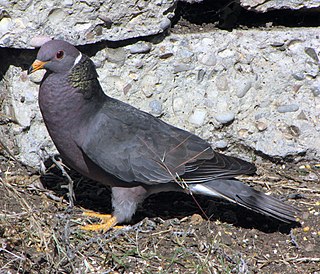
The band-tailed pigeon is a medium-sized bird of the Americas. Its closest relatives are the Chilean pigeon and the ring-tailed pigeon, which form a clade of Patagioenas with a terminal tail band and iridescent plumage on their necks. There are at least 8 sub-species, and some authorities split this species into the northern band-tailed pigeon and the southern band-tailed pigeon.

The scaled pigeon is a large New World tropical dove. It is a resident breeder from southern Mexico south to western Ecuador, southern Brazil, northern Argentina, and Trinidad.

The red-billed pigeon is a relatively large, robust species of pigeon. It's breeding range extends from southern Texas, United States, to Costa Rica. It's primarily found throughout coastal and lowland areas of Mexico and Central America. It belongs to a clade of Patagioenas which generally lack iridescent display plumage, except some vestiges in the pale-vented pigeon.
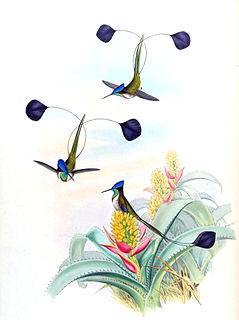
The marvelous spatuletail is an Endangered species of hummingbird in the "brilliants", tribe Heliantheini in subfamily Lesbiinae. It is endemic to northern Peru.

The white-vented plumeleteer is a species of hummingbird in the "emeralds", tribe Trochilini of subfamily Trochilinae. It is found in Colombia, Ecuador, Panama, Peru, and Venezuela.
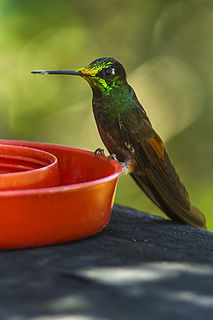
The rainbow starfrontlet is a species of hummingbird in the "brilliants", tribe Heliantheini in subfamily Lesbiinae. It is found in Ecuador and Peru.
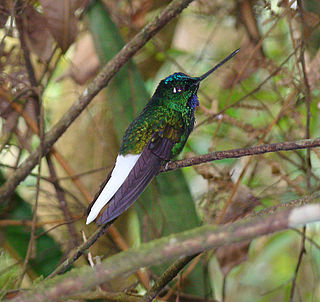
The white-tailed starfrontlet is a species of hummingbird in the "brilliants", tribe Heliantheini in subfamily Lesbiinae. It is endemic to the Sierra Nevada de Santa Marta of northeastern Colombia.

Humboldt's sapphire or Humboldt's hummingbird is a species of hummingbird in the "emeralds", tribe Trochilini of subfamily Trochilinae. It is found in Colombia, Ecuador, and Panama.
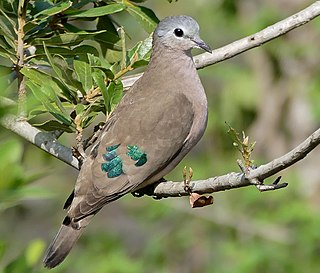
The emerald-spotted wood dove is a bird of the family Columbidae, resident across eastern and southern Africa. It is a species of open drier deciduous woodland and second growth. It is absent from evergreen rainforests and semidesert areas.

The banded ground cuckoo is a Endangered species of cuckoo in the tribe Neomorphini of subfamily Crotophaginae. It is found in Colombia and Ecuador.

The crested quail-dove is a species of bird in the family Columbidae. It is endemic to Jamaica.

The Chilean pigeon is a species of bird in the family Columbidae. It is found in Chile and Argentina.

The bare-eyed pigeon is a species of bird in the family Columbidae. It is found in Colombia, Venezuela, and the Netherlands Antilles.

The dusky pigeon is a species of bird in the family Columbidae. It is found in Colombia and Ecuador.

The plain pigeon is a species of bird in the family Columbidae. It is found in Cuba, Hispaniola, Jamaica, and Puerto Rico. Its natural habitats are forest, woodland, coastal desert, mangrove and swampy areas. It is threatened by habitat loss.

The spot-winged pigeon is a species of bird in the family Columbidae. It is found in Argentina, Bolivia, Brazil, Chile, Paraguay, Peru, and Uruguay.

The Maranon pigeon or Peruvian pigeon is a species of bird in the family Columbidae. It is found in Ecuador and Peru.

The plumbeous pigeon is a species of bird in the family Columbidae. It is found in Bolivia, Brazil, Colombia, Ecuador, French Guiana, Guyana, Panama, Paraguay, Peru, Suriname, and Venezuela.

The long-tailed ground dove is a species of bird in the dove and pigeon family, Columbidae. It is found in Bolivia and Brazil.























